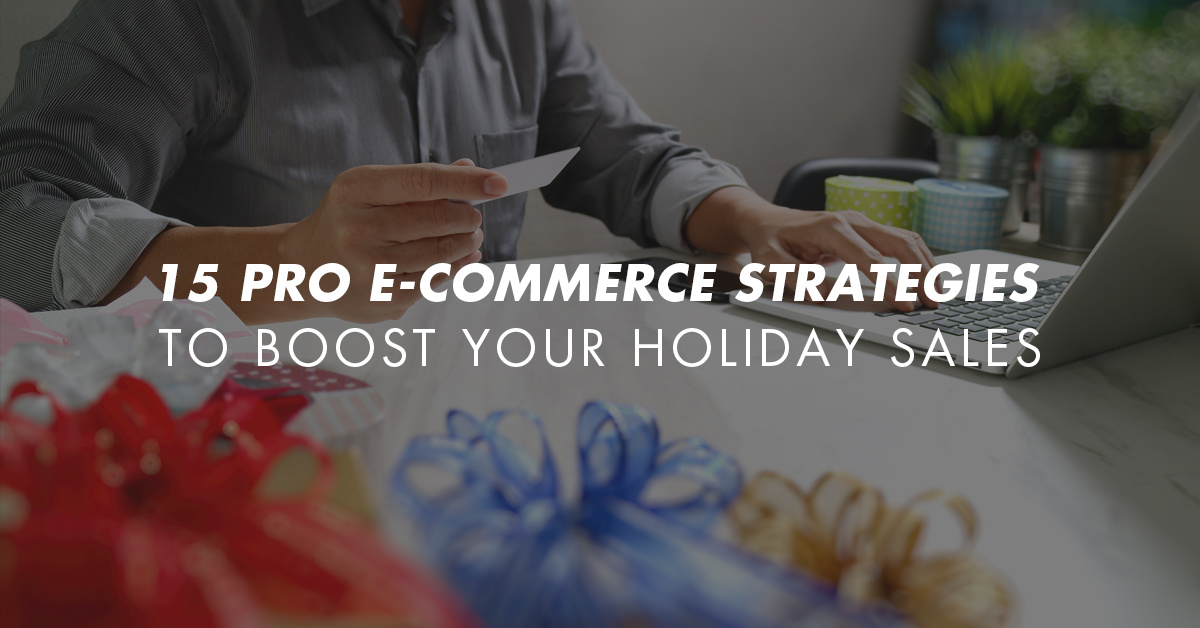3 min read
5 Must-Haves for your Cannabis Website to Help Drive Sales
The popularity of cannabis products has far exceeded its original connotation with the 70s and is now widely used by people from different...
Improve customer satisfaction and increase operational efficiency with a client portal.
Take control of your operations with customized software solutions.
Help your in-house dev team get more done, faster with our Midwest-based experts.
The holiday season is not just a time for festivities and cheer, it’s also the peak selling period for online retailers. As an e-commerce business, it’s important to capitalize on new strategies and spruce up your online storefront to capture the holiday shopping rush.
Below we’ve compiled 15 pro tips to help you boost your e-commerce sales this season.
Most people are shopping from their phones, so you need to make sure that there are no mobile design quirks or functionality bugs that would make it difficult or unappealing to browse and purchase from your website.
Now is the time to double and triple-check how everything looks and what the overall shopping experience feels like on mobile. Only testing the look and the experience from a desktop or laptop computer it not going to cut it. There are too many subtle “flaws” that you may not see if you’re not testing from a phone.
If you find that your mobile design needs some tweaking or the process of browsing and checking out is clunky, make the necessary updates to ensure it doesn’t hinder your holiday sales.
As a general guideline, prioritize speed and simplicity. Nobody expects online shopping to be difficult or confusing. Keep things simple and to the point.
Get shoppers in the holiday spending mood by updating your website design with holiday themes that create a festive mood. While throwing some snowflakes in the header of your website may be a good start, consider something a little bit more to stand out from the crowd.
Start by making sure you have one or more holiday deals or discounts to offer. When doing so, make sure to update your imagery to match the holiday season. The Bath & Body Works screenshot below is a great example of how your imagery can be updated to have a festive theme.
To take it one step further, create some holiday shopping content such as gift guides, holiday FAQs, and themed shopping categories. This will greatly enhance the customer experience and may spark some new ideas that your shoppers may not have thought of themselves.
Capitalize on organic search traffic by optimizing for holiday-specific keywords. This will involve writing some content that is helpful for your buyer around the holidays. Adjust your seasonal SEO strategy to combine your normal target keywords with additional words like “holiday deals,” “Christmas gifts,” or “New Year sales”.
For example, let’s say you sell consumer electronics. You would be wise to write a helpful article like “Most Wanted Tech Gadgets this Holiday Season.” In that article, you can promote the gadgets that you sell that are popular and provide links to buy those gadgets from your website.
The great thing about this content, if written broadly to the holidays, is that it can be tweaked and re-used every year. Therefore, whatever search ranking you have built up will continue to benefit you every year around the holidays.
The holiday season means increased traffic. Ensure your hosting can handle the spike without slowing down. Slow sites lose customers, so it’s imperative to have quick load times.
If your hosting provider is letting you down, now is the time to invest in high-performance website hosting. Click here to learn more about our fully-managed WordPress hosting solution.
We recommend a managed hosting solution (vs unmanaged) so that you’re not wasting valuable time tinkering with performance settings and worrying about the security of your website when you should be engaging with your customers.
With increased traffic comes a higher risk of cyber threats. We highly recommend you take the following 3 actions to check security on your website:
#1: Make sure you have a valid, working SSL certificate installed.
This ensures that all traffic between your customer and your website is encrypted.
#2: Make sure your WordPress installation and all of your 3rd party plugins are up-to-date.
Outdated plugins and WordPress installs are one of the biggest culprits when it comes to WordPress website security.
#3: Run a vulnerability scan on your website.
You need to make sure there are no high priority vulnerabilities that need to be patched. This can typically takes a few hours and produces an in-depth report of any vulnerabilities you have, ranked by priority. Ensure there are no critical or high priority vulnerabilities present on your site.
Bonus Tip: Secure Your WordPress Backend with Two-Factor Authentication (2FA)
2FA adds an essential layer of defense, safeguarding your site from unauthorized access. It works by requiring a second form of verification – beyond just a password – such as a code sent to your phone or generated by an app. This makes it significantly harder for cybercriminals to breach your admin area, even if they manage to get hold of your password.
In today’s digital landscape, where hacking attempts are increasingly sophisticated, enabling 2FA on your WordPress site isn’t just a recommendation; it’s a critical step in ensuring the safety of your online business, your customer’s data, and your peace of mind during the high-traffic holiday season.
Customers want to know their personal and financial information is safe. By following the 3 steps plus the bonus tip above, you greatly reduce the chances that your website will cause you security headaches this holiday season.
A complicated checkout process will have huge consequences for your online sales. You need to make it as quick and easy as possible to complete a purchase.
According to a study by the Baymard Institute, approximately 69.80% of online shopping carts are abandoned, and one of the major contributing factors to this high abandonment rate is a complicated or lengthy checkout process. Specifically, 18% of shoppers have abandoned a cart due to a long and complicated checkout process.
Streamline your checkout process by following these 6 helpful tips:
#1: Minimize Steps: Keep the checkout process as simple as possible. Ideally, aim for a single-page checkout where customers can enter all their information on one screen without having to navigate through multiple pages.
#2: Provide a Guest Checkout Option: Allow customers to make purchases without the need to create an account. Forcing users to register can be a significant barrier and often leads to cart abandonment.
#3: Show Clear Progress Indicators: If your checkout process involves multiple steps, use clear progress indicators to show customers where they are in the process and how many steps remain. This helps in managing expectations and keeps them engaged.
#4: Give Multiple Payment Options: Offer a variety of payment methods, including credit cards, PayPal, Apple Pay, Google Pay, and other popular digital wallets. This flexibility caters to different preferences and can speed up the checkout process.
#5: Provide Auto-Fill Capabilities: Implement auto-fill technology to reduce the amount of typing customers need to do. For repeat customers, offer the option to save their information for future purchases.
#6: Limit Upsells and Distractions: While it’s tempting to upsell at checkout, too many options or distractions can overwhelm customers. Keep it minimal and focused on completing the sale.
High shipping costs passed along to the buyer and inadequate shipping options can be a deal breaker for many online shoppers. Offer competitive options like free shipping, expedited shipping for last-minute shoppers, and easy return policies.
Transparency in shipping times and costs is crucial to maintain customer trust and satisfaction. Whatever shipping options you offer, make sure you are able to deliver on the customer’s expectations to ensure they come back for future shopping needs.
Craft targeted email campaigns to bring past customers back to your store. Marketing platforms like HubSpot allow you to target your customers based on past buying behaviors.
Make sure to personalize your emails with recommendations based on previous purchases and browsing history. Remind customers of cart items they may have forgotten and nudge them with limited-time offers.
Your social media platforms are a goldmine for engagement and driving sales. Create shareable content, holiday giveaways, and exclusive social media deals. Use features like shoppable posts to reduce the steps from discovery to purchase.
For example, utilizing shoppable posts on Instagram is a great way to engage with your audience and boost sales, especially during the holiday season.
Here’s an example of how you could craft a shoppable post on Instagram:
Image: A high-quality, visually appealing photo featuring a selection of your products in a festive setting. This could be a beautifully decorated room with your products as gifts under a Christmas tree, or a cozy winter scene with your products being used or worn. Ensure the products are clearly visible and the overall aesthetic aligns with your brand.
Caption: Craft a festive and engaging caption that resonates with the holiday spirit. Start with a warm, holiday-themed greeting, then briefly highlight the featured products.
Example: “🎄✨ Get ready to spread the holiday cheer! Our Winter Collection is here to make your season bright. From cozy [Product Name] to the perfect gifts like [Product Name], we’ve got your holiday shopping covered. Tap to shop and bring the joy of the season home! 🎁❄️ #HolidayShopping #FestiveFinds”
Hashtags: Include relevant hashtags like #HolidayGifts, #ChristmasShopping, #WinterEssentials, etc., to increase the visibility of your post.
Tags: Use Instagram’s shopping feature to tag the products in the image. When users tap the photo, they’ll see tags on each product. These tags can show the product name and price, and when clicked, will take the user directly to the product page on your website where they can make a purchase.
Stories and Highlights: Supplement your post with Instagram Stories showcasing the products, perhaps with a quick video or a series of images. You can also use the ‘Swipe Up’ feature to direct users straight to your product page if you have access to it. Save these stories to a ‘Holiday Collection’ highlight on your profile for easy access.
Engagement: After posting, engage with your audience. Respond to comments and messages to create a sense of community and encourage further interaction.
As you can see in this example, by leveraging Instagram’s shoppable posts feature, you make it easier for customers to go from inspiration to purchase without leaving the app, tapping into the convenience that many online shoppers appreciate, especially during the busy holiday season.
PPC advertising can provide a significant boost in visibility during the holidays. Create holiday-themed ad campaigns targeting your main keywords, but also include “holiday gifts” and “online deals” to further target your holiday shoppers.
Customer service often suffers during the holidays as stores deal with an influx of shoppers with not enough staff to accommodate everyone’s requests. Be prepared with chat support, a well-trained team, and self-service options such as a comprehensive FAQ section. If you are able to be timely and helpful with your customers, you will be able to turn a one-time buyer into a loyal customer.
Personalization is the key to standing out. Use data analytics and custom software integrations to provide personalized product recommendations, deals, and content that resonate with individual customers’ preferences and previous shopping behavior.
Monitor your website analytics to understand customer behavior better. Look for patterns in traffic, conversion, and bounce rates to make informed decisions on inventory, marketing strategies, and website design adjustments.
Stock up on your best sellers and ensure that your inventory management system is integrated with your website in real-time. Nothing is more disappointing to a customer than finding out a product is out of stock after deciding to buy.
Lastly, be agile. The best-laid plans can encounter unexpected hitches. Keep an eye on performance metrics and be ready to adapt your strategies as needed. This could mean tweaking your ad spend, posting impromptu social media updates, or quickly fixing any website issues.
The holiday season is a time of significant opportunity for ecommerce businesses. By focusing on customer experience, leveraging technology, and optimizing your online presence, you can unwrap the gift of increased sales and customer loyalty.
From all of us at Onsharp, we wish you a prosperous and joyful holiday season. Let’s make those sales numbers as dazzling as the holiday lights!
Ready to sleigh your holiday campaigns? Use this guide to help you ensure your holiday season campaigns not only sparkle but ring in success.

3 min read
The popularity of cannabis products has far exceeded its original connotation with the 70s and is now widely used by people from different...

3 min read
Every entrepreneur’s nightmare is having their website hacked – not only for the security of client information, but also for the brand’s...

5 min read
Reliable, fast, and secure website hosting is a critical part of running a successful website, and the company you choose to host your...
